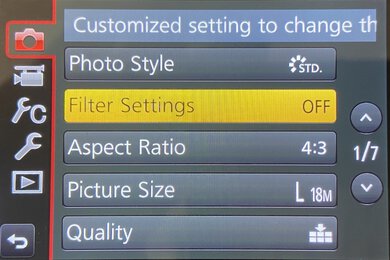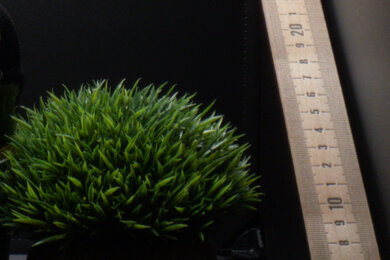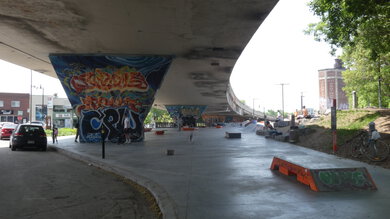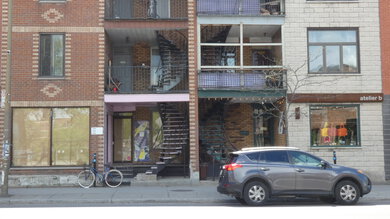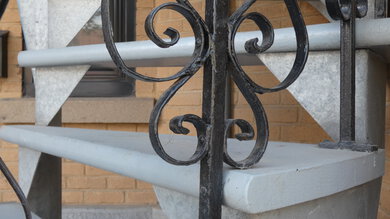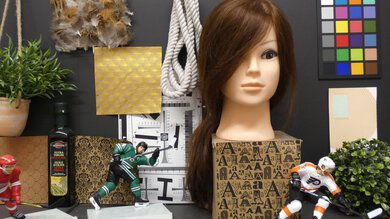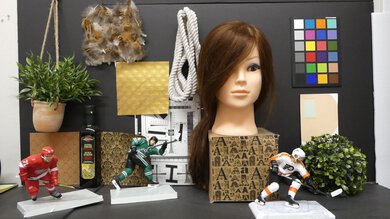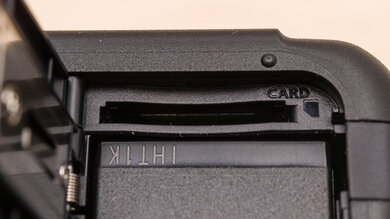The Panasonic LUMIX FZ80 is a budget bridge camera. It has a 20-1200mm equivalent zoom lens, making it a great choice for casual shooters who want to take decent-quality photos with the flexible focal range of a superzoom lens. It's more portable than a lot of higher-end bridge cameras and offers a lot of value for its price, despite its plasticky build quality.
Our Verdict
The Panasonic LUMIX FZ80 is okay for travel photography. Its built-in lens has a very wide focal range, meaning you can frame subjects up close and far away. Images look okay straight out of the camera, though the camera isn't well-suited to nighttime photography since images can lose sharpness and clarity even at moderately low ISO levels. Its autofocus system does well with still subjects, but it can be slow to focus and sometimes struggles to track moving subjects. That said, its 'Post Focus' and 'Focus Stacking' features can help you adjust focus after you've taken a shot or expand the focal range. Its optical image stabilization feature also does a good overall job of smoothing out camera shake and allows you to snap photos at reasonably slow shutter speeds. The camera is fairly comfortable, but it has a fixed screen and a small, low-res viewfinder. It's also somewhat bulky, making it more hassle to travel with.
- Comfortable to use.
- Screen is bright enough to be seen under direct sunlight.
- Good optical image stabilization.
- Poor image quality in low light.
- Not the most portable.
- Small, low-resolution EVF.
The Panasonic LUMIX DC-FZ80 is sub-par for landscape photography. It can shoot at a wide-angle 20mm equivalent focal length, which is great for capturing landscapes. However, its small sensor yields JPEG images lacking in sharpness and color accuracy. On top of that, its RAW files give you very little latitude to make adjustments in editing, with poor dynamic range and a lot of noise at even moderate ISO settings. It also feels slightly cheaply built courtesy of its sensitive multifunction dial, plastic body, and lack of proper weather-sealing. On the upside, it's pretty comfortable to shoot with and has a touchscreen interface that's bright enough to see even under direct sunlight, although the fixed screen makes it harder to compose shots when using a tripod.
- Comfortable to use.
- Screen is bright enough to be seen under direct sunlight.
- Fairly wide-angle minimum focal length.
- Poor image quality in low light.
- Not the most portable.
- Small, low-resolution EVF.
- Poor dynamic range.
The Panasonic LUMIX FZ80 is okay for sports and wildlife photography, especially for more casual use. Its '4k PHOTO' feature lets you pull stills from short 30 fps video clips, allowing you to capture the perfect moment of action. It also has a fairly quick burst rate in its high-speed continuous shooting mode. The built-in lens' long focal length can help you zoom in on far-away subjects, like athletes in a stadium or race cars circling a track, and its optical stabilization feature smooths out a good amount of camera shake. Its autofocus system does a great job tracking slow-moving subjects but struggles more with faster-moving subjects and face-tracking. It can also be slow to focus, which isn't ideal when timing is critical. Still, its 'Post Focus' and 'Focus Stacking' features can help you fine-tune the focus even after the photo has been taken. Unfortunately, the camera feels a little cheaply built, and though it has an electronic viewfinder, it's very small and has a low resolution, making it harder to get a clear view of your subjects.
- Comfortable to use.
- Long zoom range.
- Fast maximum shooting speed.
- Poor image quality in low light.
- Not the most portable.
- Small, low-resolution EVF.
The Panasonic FZ80 has poor RAW photo performance. Its dynamic range is very limited, so you'll lose out on shadow or highlight detail in high-contrast scenes. It's also a poor choice for low-light shooting, with bad noise handling in low light and a very limited max ISO of 3200. That said, it has a reasonably high-resolution sensor, and its overall image quality isn't bad for a budget bridge camera, so you can still get good results in bright lighting conditions.
- Images look passably sharp and detailed in bright lighting conditions.
- Poor image quality in low light.
- Poor dynamic range.
The Panasonic LUMIX FZ80 isn't suitable for vlogging. You can't see its fixed screen when the camera is pointed at you, and its bulky design can make it impractical to carry around handheld for long periods. Video quality is also quite noisy and soft, and while the camera does a good job of smoothing out camera shake in FHD, it struggles in this regard when recording in 4k. Recording in 4k also incurs a somewhat noticeable 1.27x crop, and its autofocus system can be sluggish and inconsistent, especially when tracking faces.
- Good video stabilization performance in FHD.
- Poor video quality.
- Not the most portable.
- Can't see the fixed screen when the camera is pointed at you.
- Noticeable crop when recording in 4k.
- Autofocus is sluggish and unreliable for video.
The Panasonic LUMIX FZ80 is inadequate for studio video. Video quality is poor whether you're recording in 4k or FHD, with softly-defined object contours, edges, and textures in well-lit environments and noticeable amounts of noise in dimmer settings. There's also a significant 1.27x crop when shooting in 4k, and the camera lacks inputs and outputs, with no headphone or microphone jacks and an HDMI port that only supports external playback. Its autofocus system also has a hard time tracking moving subjects. Thankfully, the camera's menu system is easy to use.
- Simple menu system.
- Poor video quality.
- Small selection of inputs and outputs.
- Noticeable crop when recording in 4k.
- Autofocus is sluggish and unreliable for video.
The Panasonic LUMIX DC FZ80 is not designed for action video, which isn't surprising as a bridge camera. It's too big to mount onto a chest or helmet rig, and it isn't waterproof or impact-resistant. It also struggles to smooth out camera shake in 4k, though it does a good job in this regard when shooting in FHD. It can't record at more than 60 fps in FHD and 30 fps in 4k, so you can't generate smooth slow-motion footage in either resolution.
- Good video stabilization performance in FHD.
- Poor video quality.
- Middling video stabilization performance in 4k.
- Not the most portable.
- Noticeable crop when recording in 4k.
Changelog
-
Updated Dec 18, 2024:
We added a comparison to the KODAK PIXPRO AZ528 in the Portability box.
- Updated Sep 04, 2024: We updated the 'Differences Between Variants' section with information about the Panasonic LUMIX FZ80D variant, released in 2024, and added comparisons in the Viewfinder, Screen, and Inputs / Outputs boxes.
- Updated Jan 29, 2024: Added text to the 'Raw Photo Performance' verdict box and updated existing verdict boxes for clarity and accuracy.
- Updated Jan 29, 2024: Converted to Test Bench 0.12.1.
Check Price
Differences Between Sizes And Variants
The Panasonic LUMIX FZ80 is only available in one color: Black. In Europe, the FZ80 is also called the FZ82, while in Japan, it's called the FZ85. You can see our unit's label here.
Panasonic released an updated version of the FZ80 in 2024, called the Panasonic LUMIX FZ80D. This newer variant features a larger, higher-resolution EVF (2.36 million dots vs 1.17 million dots) and a higher-resolution LCD screen (1.84 million dots vs 1.04 million dots). In addition, it features a USB-C port rather than the Micro USB port found on the original FZ80. It comes at a slight premium in price, but otherwise, features the same sensor and performs largely the same.
Let us know in the comments if you come across another variant of this camera.
Popular Camera Comparisons
The Panasonic LUMIX FZ80 is a budget bridge camera. It offers a lot of value for its price, with a long zoom range and helpful extra features like 'Focus Stacking,' but it feels fairly cheaply built. Its small sensor is limited for image and video quality, so it's best suited to shooting outdoors in very bright conditions on occasions where a lot of zoom comes in handy.
For more options, see our recommendations for the best bridge cameras, the best point-and-shoot cameras, and the best cameras under $500.
The Canon PowerShot SX70 HS and the Panasonic LUMIX FZ80 are both solid bridge cameras. The Canon is a bit more premium, with a fully articulating screen and slightly better build quality. It also has a slightly longer zoom range, though the Panasonic isn't far off. On the other hand, the Panasonic has a more effective autofocus system. Its lens also opens up to a wider max aperture, giving you a tad more leeway in dimmer lighting conditions, though neither camera is very well-suited to low-light shooting. Still, for those reasons, the Panasonic camera offers a bit more value for its price.
The Panasonic LUMIX FZ1000 II is a better overall camera than the Panasonic LUMIX FZ80. Both are bridge cameras with long built-in zoom lenses, but the FZ1000 II uses a slightly larger sensor, giving it better image and video quality. It also has a longer battery life, a larger, higher-resolution viewfinder, and a fully articulated screen. It feels more comfortable to shoot with, but it isn't as portable as the FZ80, and because of its sensor size, it has a shorter focal reach.
The Panasonic LUMIX FZ80 is better overall than the KODAK PIXPRO AZ528. It offers better value, with a lot more features, including a viewfinder, RAW photo support, 4k video capability, as well as better autofocus and continuous shooting capabilities.
The Panasonic LUMIX FZ80 and the Canon EOS R are different camera types. The Canon is an interchangeable lens mirrorless camera with a full-frame sensor, while the Panasonic is a fixed-lens budget bridge camera with a small sensor. The Panasonic offers convenience for those who don't want to switch out different lenses, giving you a lot of zoom range in an all-in-one package. However, the Canon is a significantly better camera, giving you better image and video quality, sturdier weather-sealed construction, longer battery life, and quicker, more accurate autofocusing, to name some advantages.
Test Results

The Panasonic LUMIX FZ80 isn't especially portable, though it's pretty lightweight for a bridge camera. If you'd prefer a more portable point-and-shoot, the Panasonic LUMIX ZS80 offers similar performance in a more compact package, though it doesn't have quite as long a zoom range. For a more portable bridge option, consider the KODAK PIXPRO AZ528.
There's a single control dial on the back of the camera near the thumb rest. By default, it controls shutter speed or aperture when in Manual mode; pressing the dial toggles between the two. The camera also has three physical 'Fn' buttons as well as several others you can access on the touchscreen, all of which are customizable.
This camera feels quite comfortable to shoot with. It has a large, rubberized handgrip suitable for all hand sizes and feels secure in the hand. The screen has full touch capability, making it easy to navigate the menu, but it's fixed, making it harder to shoot from lower angles. Some of the buttons, like the directional pad on the back, are on the small side, so it's easy to accidentally press the wrong input. The command dial button press is also very sensitive. Also, there's no eyecup around the viewfinder, so it isn't very comfortable.
The electronic viewfinder is very small. The relatively low resolution combined with a very small 0.46x magnification makes it hard to see your shots clearly through the viewfinder. The plastic around the EVF with no eyecup also makes it uncomfortable to use. It also lacks an eye sensor, so you have to manually press the 'LVF' button to switch between the screen and EVF, which is a minor inconvenience but can still be annoying if you want to switch seamlessly between the screen and the viewfinder. If you prefer a higher-resolution EVF, consider the Panasonic LUMIX FZ80D variant instead.
The Panasonic FZ80 has a fixed screen, which is limiting if you want to shoot vlogs or take selfies. It's also harder to take shots from lower angles. It gets bright, so you can still see it in sunny conditions, and it has a fairly high resolution, so the image looks sharp. Thankfully, it has full touch capability, and you can use it to navigate settings, pull up the 'Fn' menu, select focus points, or set it to use as a touch shutter. If you prefer a higher-resolution display, consider the Panasonic LUMIX FZ80D variant instead.
The menu system is very easy to use, thanks to its simple layout and organized tabs. You can easily navigate through it using the directional pad or tapping the touchscreen. It also has a lot of customization options, including customizable tabs on the screen and an 'Fn' menu for commonly used settings. There's also a display option that lets you see all of your shooting settings at once. From there, you can adjust relevant settings as needed, but you can't see your subject on screen or through the viewfinder with this display engaged.
Battery performance is decent. It supports USB charging, so you can use a portable battery pack for longer shooting days, though you can't shoot with it while it's charging.
The Panasonic FZ80 has a good continuous shooting speed, and it shoots at a fairly quick rate in its high-speed drive mode, allowing you to capture bursts of fast-moving action. Though it isn't the fastest burst rate, it's still fairly quick for casual sports and wildlife photography, where timing plays a more important role anyway. Unfortunately, it has a small photo buffer, especially if you shoot in RAW. Thankfully, the camera clears its buffer fairly quickly, but it can still slow you down or interrupt your shooting at a critical moment.
The camera also has a '4k PHOTO' mode that lets you pull still frames out of 4k video clips shot at 30 fps, making it easier to freeze moments of fast action.
The Panasonic FZ80 uses a contrast-detect AF system with Panasonic's Depth From Defocus (DFD) technology. Contrast detection systems tend to be slower to focus; DFD is meant to help speed up the process by quickly comparing the sharpness of images taken at two different distances to get a better sense of how far the subject is from the lens.
As far as continuous tracking goes, it supports eye and face tracking and does a passable job keeping moving human subjects in focus when moving at a moderate pace, though it struggles to keep them in focus when moving more quickly.
Autofocus is a lot more reliable when you set the focus point yourself rather than relying on the AI to track subjects automatically. The camera can keep focus on subjects in the center point fairly well, though it can still sometimes fail to keep pace.
The camera also has some extra features to help you fine-tune the focus. 'Post Focus' takes a 4k 30 fps burst at different focus points, allowing you to change the focus after taking a shot. This is great for macro work or photos of still subjects, where you might want to adjust the exact focus point or emphasize different parts of an image. There's also a 'Focus Stacking' feature, which combines several images taken with different focus points to produce a single image with an expanded focus range. You can use this to ensure that your entire subject is in focus. The camera also has an 'AF Macro' feature that adjusts the minimum focus distance to 0.39 inches (1 cm), so you can focus on subjects very close to the lens.
The Panasonic LUMIX DC FZ80 uses optical image stabilization instead of in-body sensor-shift stabilization. It does a good job of steadying the shot when taking photos, allowing you to get clear shots at speeds as slow as 1/15s. That said, stabilization performance varies when shooting at longer focal lengths. You'll likely need a tripod to steady shots taken at the farthest end of this camera's focal length range.
The Panasonic LUMIX FZ80 has poor dynamic range, so it can't capture a very wide range of shadow and highlight detail. It's disappointing even at its base ISO and gets progressively worse when using higher ISO settings with shorter exposure times, giving you even less range to work with when shooting in low light. There's very little exposure latitude as well, as trying to recover shadow detail in underexposed images results in unusable levels of noise.
The camera doesn't resolve fine details super well because of its small sensor. While this is most evident when pixel-peeping or cropping your photos, images generally don't look as clear or detailed as those taken on cameras with larger sensors and higher resolutions.
The Panasonic LUMIX FZ80 has poor RAW noise handling. Noise becomes noticeable very quickly as you raise the ISO, and its ISO maxes out at 3200, meaning this camera isn't well-suited to shooting in low light. It's very difficult to recover all the details in an image when processing your RAW files unless you take your photos in very bright, sunny conditions, which is where this camera performs best.
Unfortunately, the Panasonic LUMIX FZ80 can only record 4k video at 30 fps with a noticeable 1.27x crop. Because of the crop factor, the equivalent focal length range also changes from 20-1200mm to 28-1680mm.
Internal recording capability in 4k is decent, although the camera can only output lower-quality video files under 100 Mbps. It's also limited to 8-bit 4:2:0 color, so there's less information to work with when processing video footage. 4k video caps at 15 minutes of continuous recording, so it's not great for shooting longer takes. On the upside, it doesn't overheat when recording 4k video continuously.
The Panasonic FZ80 has disappointing autofocus performance in 4k. It struggles to stick with moving subjects and is slow to find its target and refocus after it's moved. Though it supports face and eye detection, its face tracking is very hit-or-miss, especially when subjects are moving more quickly or moving in and out of frame.
The rolling shutter effect on the Panasonic FZ80 isn't too bad. There's still some noticeable skewing of vertical lines, which can be especially distracting if you're moving or panning the camera very quickly, but it isn't too noticeable with slower camera movements.
There's only a couple of frame rate options in 1080p, but thankfully there's no crop. Though there isn't any high frame rate mode in Full HD, it does have a 'High Speed Video' option that can record 720p/120 fps or 480p/240 fps to capture slow-motion videos without sound if you want to incorporate slow-mo footage.
Internal recording in 1080p is decent. You can record continuously for up to 30 minutes, which is good for longer takes. It can only record at fairly low bit rates, so it captures less data per second, resulting in lower-quality video. Unfortunately, the camera is limited to 8-bit 4:2:0 color, giving you less latitude when editing.
Autofocus performance is okay in 1080p. It can track people reasonably well, though it's not especially "sticky" when those subjects are moving more quickly or popping in and out of frame. It also sometimes struggles to find a subject again after losing track, causing some distracting pulsing as the camera hunts to find its target.
The rolling shutter effect is okay in 1080p. It's noticeable with skewed vertical lines when the camera is panning very quickly but isn't too bad with slower camera movements.
The Panasonic LUMIX FZ80 has a limited selection of inputs and outputs. There's no microphone input, meaning you need to record audio separately if you don't want to use the camera's built-in mic. Also, while it has a Type-D Micro HDMI port, it only supports playback on an external device, not external recording. The newer Panasonic LUMIX FZ80D features a more modern USB-C port for charging.








